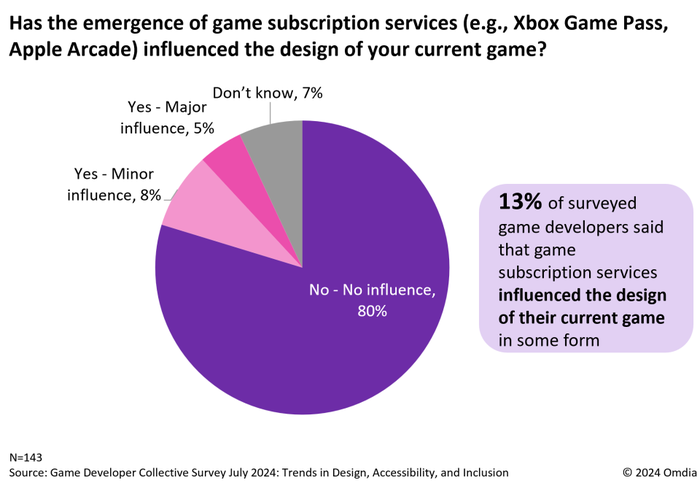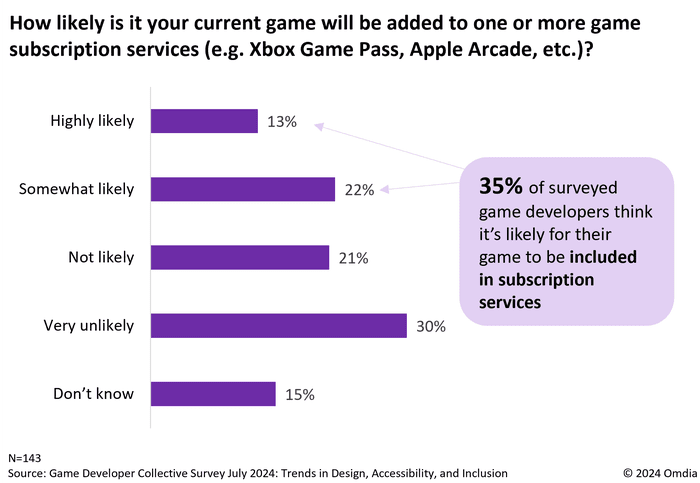Game subscription services like Xbox Game Pass, Apple Arcade, and PlayStation Plus have ushered in a new paradigm in the industry, promising benefits to both gamers and developers. While 168 million global subscriptions represent a significant opportunity for broader reach and continued revenue, developers are treading carefully.
A survey from July 2024 Game Developers Collective reveals that while many developers are optimistic about their games being included in subscription services, few are adapting their game designs specifically for these platforms. Undoubtedly, the slowdown in game subscription adoption since the pandemic has been a key factor in this moderate approach.
This contrasts with the experience of other industries, such as music, where streaming services have had a significant impact on songwriting, with artists adapting to fit algorithms and playlists. The key difference is that music subscriptions account for more than two-thirds of industry revenue, compared to less than 10% for games, while game developers face a much more opaque payment model.
According to the survey, 35% of game developers believe it is likely that their current game will be added to one or more subscription services. However, when asked if subscription models have influenced the design of their current game, only 13% indicated that subscription services have had an impact on their development process. A surprising 80% said that these services have had no influence at all. These numbers reveal a gap between interest in inclusion and active adaptation to the unique requirements of subscription platforms.
Limited design adaptation indicates industry hesitation regarding subscriptions
Uncertainty about how subscription services will impact developers’ long-term revenue models is likely driving this caution. The most successful subscription platforms, like Xbox Game Pass, often provide developers with lucrative upfront payments in exchange for their games being included on the service. But for smaller titles or those without obvious potential for success, ambiguity about whether their games will be selected for a subscription service makes it difficult to rely on subscriptions as a revenue stream.

Games designed with subscription models in mind need to capture players' attention quickly, as subscribers have access to a large library and can easily move on if they aren't engaged early. A separate consumer survey by Omdia found that four in ten subscribers try new games for just 30 minutes or less before deciding to commit. However, 80 percent of developers surveyed were reluctant to make major design changes, such as pre-loading exciting content right at the start of a game, that could favor these platforms (see graph above).
Subscription opportunities remain attractive for developers
Despite the reluctance to change game design, the general appeal of subscription services cannot be denied: 35% of developers expect their current game to be added to a subscription service (see the graph below). Developers recognize the potential to reach a wider audience, especially through services like Xbox Game Pass, which boasts more than 34 million subscribers worldwide. For some developers, inclusion in these services provides visibility to players who might not have otherwise encountered their games. The allure of increased discoverability and long-term revenue potential has led some studios to begin exploring these platforms, even if they aren’t yet revising their design strategies.

However, these benefits are tempered by the slow subscriber growth all platforms are experiencing. After a pandemic-induced surge in 2020 and 2021, subscriber growth has slowed significantly, and while continued growth is still expected in the years to come, the massive consumer adoption some industry players are predicting remains a long way off. While subscriptions will generate $19.4 billion in 2024, that will still only account for 8.8% of global gaming content revenue this year, according to Omdia. latest report on the gaming subscription market. But while subscriptions won’t dominate the gaming market, they will complement a wide range of monetization approaches. As such, the path forward will likely involve cautious experimentation, balancing the allure of subscription platforms with the economic realities of game development.